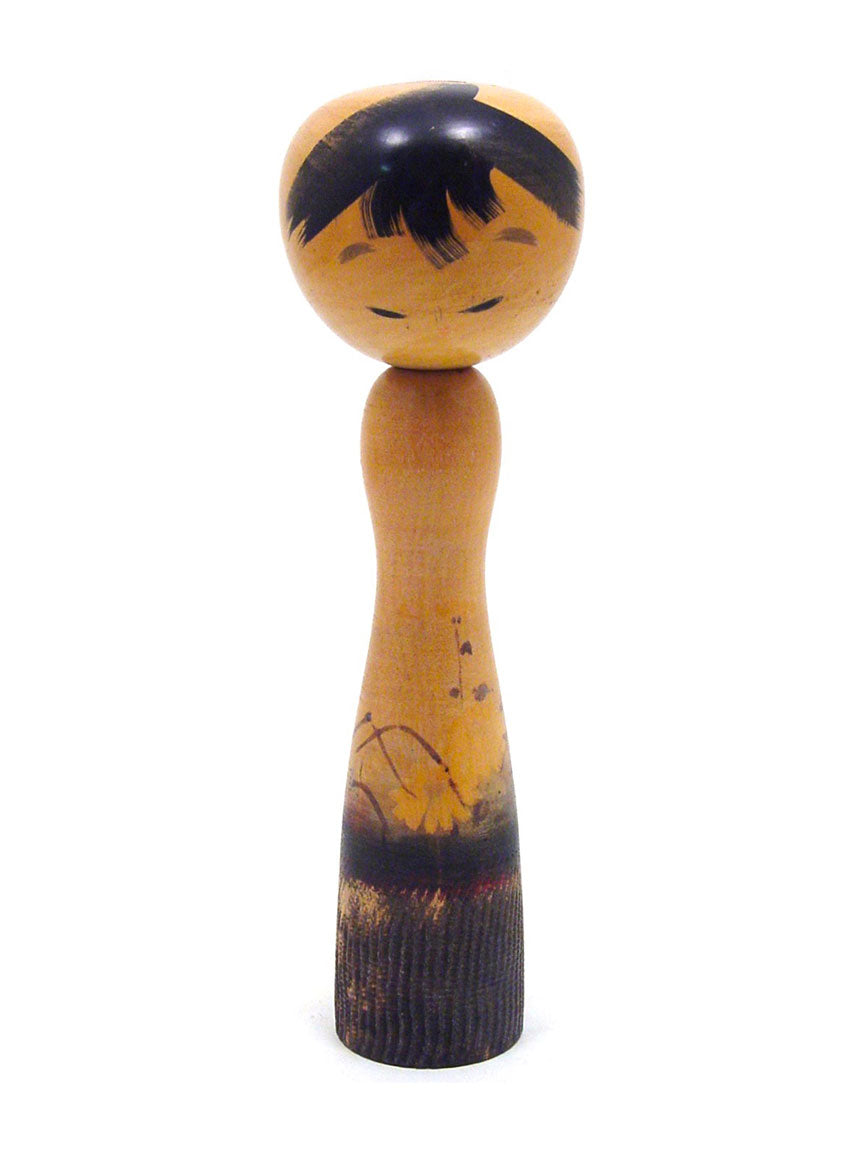
“Banshu | Late Autumn”
Dimensions: 9-1/2”h
Watanabe’s painterly abilities shine. The dolls carry the basic personality characteristics used by the artist, with the unique addition of Autumn in Japan. Additionally, he added the Chatter work to texturize the bottom of the doll. Signed and stamped on the bottom.
Vintage Condition, “As is” does not imply that the piece is completely free from the effects of aging. No discoloration, chipping/cracking, surface wear, or structural damage shown Vintage Condition: “as is” with some scattered light wear or stain that does not affect the design, and retains the original craft/workmanship. Any discoloration, chipping/cracking, surface wear, or structural damage was noted.

Artisan
Woodworker: Watanabe, Masao
1917-2007
Biographical History:
Watanabe-san is considered to be one of the greatest Sosaku Kokeshi artists in all of Japan. Born in Fukushima, Watanabe-san studied under Traditional Yajirou Master Sato, Tatsuo of Miyagi Prefecture. Arguably, the most popular and prolific of the 20th/c Sosaku Kokeshi artists, he began his craft in the early 1950s. His most famous Kokeshi themes are that of ‘innocence’ (Mushin), and his doll entitled: Chigo Zakura (Cherry Blossom Child) won the Minister’s Award and was presented to the Beatles in 1965, after their appearance in Japan with Sir Joseph Lockwood, Chairman of EMI Record Distributors, England. A multiple award winner from 1963-1981 in Kokeshi competitions around the world (Prime Minister's prizes for the works of "Chigozskura" in 1963 and "Shojo" in 1981), along with numerous prizes by the Modern Kokeshi Artist Association and JETRO. He held two exhibitions in Japan and was exempt from the examination of the All Japan Kokeshi Contest, a Member of the Nippon Kokeshi Artistic Handicraft Association. His works are permanently exhibited at the Nuremberg Toy Museum in Germany.

Collector's note – descriptive qualities, standard characteristics & ornamentation styles:
Of all the Kokeshi the emphasis is on the color of the natural wood and texture, and his diversity of form is the most recognizable characteristic of his dolls. The representation of clothing is seen in the use of the diverse rendering of Kimono, Yukata, and Haori complemented by the painted details that are common throughout his works. Several dolls not only show wonderful color rendition as well as textured/ raised applications resembling Shibori, a type of tie-dyeing that gives texture to the garment. He also prominently features the rose and camellia as a central motif along with extremely expressive eyes throughout the range of ages represented in his works.
Signature Research:
We heard from our colleague at Soulportals KokeshiVillage, a website researching vintage and contemporary Kokeshi artists and signatures. It was brought to our attention that Watanabe subcontracted an artist named Sato Norio to reproduce large numbers of his Kokeshi in the 1960s because of an enormous number of orders for his award-winning design Chigazokaura. Watanabe's signature for pieces designed and crafted by him is shown on this page celebrating a number of his award-winning dolls. Nario's versions were entitled Plum Grove and approved/attributed to Masao but not crafted by him.
Explore & Learn More about Woodworker: Watanabe, Masao